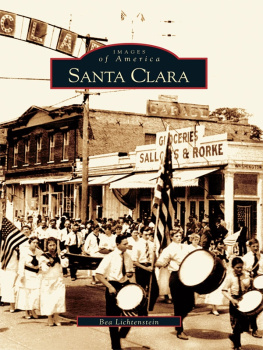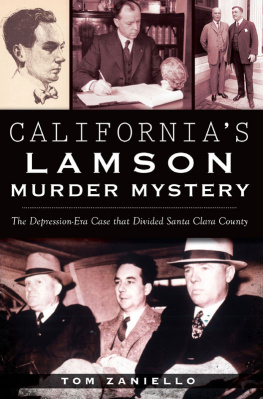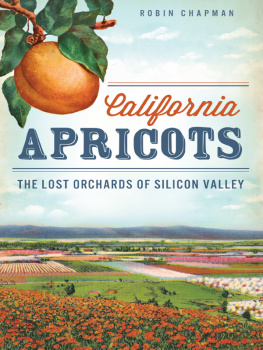CHAPTER I.
Unrivaled Climate and Situation Story of the Early Days The Founding and Growth of the Missions Founding of San Jose Secularization of the Missions Life on the Early Ranchos Early Government The First Americans The Ill-Fated Donner Party.
THERE is no county in California so rich in material, romantic, progressive and adventurous, as the County of Santa Clara. It absorbs about the whole of the Santa Clara Valley, rightly proclaimed the richest valley in the state, and in respect of size, the richest in the world. It is located at the southern end of San Francisco Bay and the county, itself, embraces 1355 square miles.
The climate is famed for its evenness and salubrity. The Mt. Hamilton Range on the east and the Santa Cruz Mountains on the west protect the valley from the heat of the San Joaquin plains and direct coast influences. The Bay has a modifying effect, its cool breezes which sweep through the valley, making the summers cooler and the winters warmer. The mean summer temperature is seventy-five degrees; winter, about sixty degrees. The average rainfall is sixteen inches for the valley and nearly twice that amount for the mountains. There is an alternation of storm and sunshine between October and May. During this period there are from thirty to forty days in which more or less rain falls; from sixty to seventy that are cloudy; the rest are bright and pleasant. These estimates vary with particular seasons, but taking the average of a series of years, it will be found that from October to May one-half the days are cloudless and fully three-fourths such that any outdoor vocation can be carried on without discomfort or inconvenience.
Cyclones and terrific windstorms are unknown and thunder is heard only at rare intervals. With the month of March the rains are practically over though showers are expected and hoped for in April. Summarizing, it may be said that in any part of the year, days too hot or too cold for the comfort of those engaged in ordinary occupations are rare. It may be added that the fears and forebodings with which the seasons are elsewhere greeted, are here unheard of. Coming with no rigors, they bring no terrors and are alike welcomed as a change. In these conditions health and comfort are largely subserved and also in them the great horticultural possibilities, and these, the elements of present and prospective prosperity, are as constant as the ocean currents in which they have their origin, as permanent as the mountain ranges which bound the field of their exhibition.
Santa Clara County is the banner fruit section of the state. In 1919 there were 98,152 acres planted in fruit trees and 2,850 acres in vines. The total acreage of cereals, vegetables and berries was 86,695 acres. The livestock numbered 62,248; value $1,288,175. It is the prune center of America. More prunes are raised in the valley than are raised in the whole United States outside. In 1919 the orchardists of the county received $45,000,000 from the product of their trees. This was irrespective of the money received from the packers and canners. In the season ending in the winter of 1919 the Southern Pacific Railway handled about 153,000,000 pounds of prunes in the territory between Hollister and San Francisco. The crop was by far the largest ever raised in the Santa Clara Valley. In 1921 the canneries of the valley paid out nearly $50,000,000 for orchard products.
Though called the "garden spot of California," this phrase should not be interpreted to make gardening more important than fruit raising, for fruit raising is the prime industry. Timber, cattle raising, dairying and sundry industries have played and still play an important part in the business life of the population, though the days of wheat raising, grazing and timber culture are passing rapidly. Lands so fertile and so adaptable to fruits and vegetables cannot, in a section that is being rapidly populated, be given over to any industry other than one that is intensive. Within the limits of the county there is practically no waste land. It is interesting to bear in mind that much of the poorer and rougher land compares more than favorably with some of the best acreage in the Eastern states.
A graphic and beautiful picture of the valley appeared in the April (1920) issue of the Southern Pacific Bulletin. It was from the pen of R. F. Wilson and is here reproduced:
"One of California's great out-of-doors treats is a trip through any of the orchard regions around the Bay of San Francisco during blossom time the end of March and the beginning of April. The visitor to San Francisco or Oakland during this period should devote a day at least to seeing one of these mountain-rimmed fruit valleys nestling among their rounded, oak-clad foothills. The beautiful valley of Santa Clara Queen of Blossom Festivals lies directly south of San Francisco, its northern gateway being at Palo Alto, twenty miles distant. It is fifty miles in length and from five to twenty miles in width, its level floors inlaid with a thousand tinted squares and rectangles of orchards, dotted with country homes and interlaced with hundreds of miles of auto roads, electric lines and railways. It is a veritable Eden, a gorgeous garden of fruit and flowers, walled in on the east by the Mt. Hamilton Range, on the south and west by the Coast Range and the Santa Cruz Mountains. This garden wall is two to three thousand feet high and 'over the garden wall' is all California, a natural setting for this wonderful valley, one of the thousand wonders on the Southern Pacific lines. In early spring you can here behold over 100 square miles of trees in snow-white blossoms prune, plum, cherry, olive, almond and with a dash of pink and red for the peach and apricot. Over 8,000,000 with billions of blossoms Santa Clara County's great White Milky Way, twinkling in the California sunlight like myriad heavenly constellations, with honey bees buzzing in the perfumed air. Have you ever seen such a sight? You may hear the Song of Spring all over the world but nowhere on earth can you duplicate the Santa Clara Valley in blossom time. You cannot match this wealth of brilliant blossom even in Japan, and Japan's cherry blossom trees are barren while California's trees bring forth luscious fruit. In late March and early April the Santa Clara Valley is a dazzling, billowy sea of foaming white caps rolling toward us from the faraway horizon. From June to November this ocean of blossom is formed into a tempting basket of assorted fruits. The valley then puts on a regal mantle, purple with prunes and plums, bright yellow with the colorful peach and apricot giving it full right to the happy title, 'The Field of the Cloth of Gold'."
The origin of the name which the county bears is thus described in a report made to the Senate under date of April 16, 1856, by Gen. Mariano Guadalupe Vallejo, then senator from the district of Sonoma entitled, "Report of Mr. Vallejo on the Derivation and Definition of Names of the Several Counties in California." In that report, he says of Santa Clara: "According to the Roman Book of Martyrs, or Martyrology, as Hortalana, the pious mother of Santa Clara, was once kneeling before a crucifix, praying earnestly that being with child she might be happily delivered, she heard a voice whispering: 'Fear not, woman, thou shalt safely bring forth'; whereupon a brilliant light suddenly illumed the place and the mother, inspired by the mysterious prediction, baptized her child Clara, which is the feminine of clear or bright. Clara was afterward sanctified, on account of her many eminent virtues and accordingly venerated by the Catholics in all Roman Catholic churches. The Mission of Santa Clara, from which the county derives its name, was founded on the twelfth day of January, 1777."





